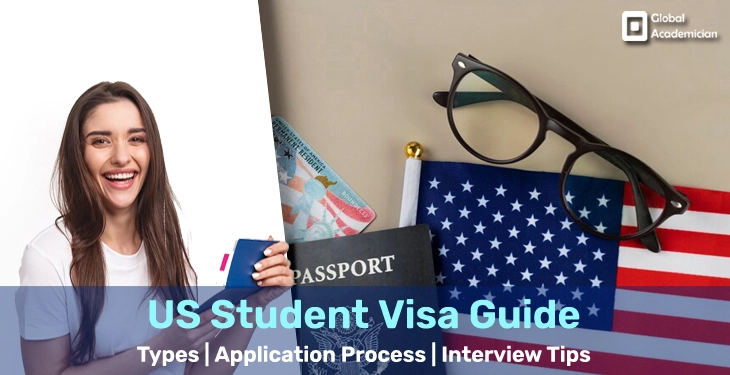US Student Visa Process: Many students dream of studying in the United States. It’s a place with lots of different kinds of schools, a reputation for great education, and a diverse culture. Getting a visa is the first step to start the education journey in United States of America.
Here, we’ll help you understand how to apply for a US student visa. We’ll explain the different types of visas, take you through the application process, and provide useful resources to make everything easier.
US Student Visa:
Why Choose a US Student Visa?
- Great Schools: The US has top universities and colleges known for their research and diverse faculty.
- Better Job Opportunities: Graduating from a US school can make it easier to find work anywhere in the world.
- Cultural Experience: You’ll meet people from all over the world and make lifelong friends.
Understanding Different Visa Options:
There are three main types of US student visas:
- F-1 Visa: For academic programs at universities, colleges, and community colleges.
- M-1 Visa: For vocational programs like cooking school or flight training.
- J-1 Visa: For exchange programs in high school, college, or professional development.
Application Process:
- Find the Right School: Look for a school that fits your interests and is approved for student visas.
- Get Form I-20: Once accepted, your school will give you Form I-20, which shows you’re eligible to study and estimates your costs.
- Pay SEVIS Fee: Register in the Student and Exchange Visitor Information System (SEVIS) and pay the fee.
- Fill Out DS-160: Complete the DS-160 form online with details about your study plans.
Interview Process:
- Schedule visa interview: After you submit DS-160, make an account on the US Department of State website and schedule an interview at a US embassy or consulate near you. Pay the visa application fee and keep the receipt.
- Attend the visa interview: Be ready to answer questions about your study plans, funding, ties to your home country, and what you’ll do after studying. Bring all needed documents like your passport, Form I-20, SEVIS fee receipt, DS-160 confirmation page, visa fee receipt, and financial documents.
- Visa issuance: After the interview, the visa officer will decide on your application. It might take some time, so be patient and follow instructions for getting your passport back with the visa decision.
Important Tips from Global Academician:
1. Tips for Preparation:
- Research and compare different SEVP-approved schools to find the best fit for your academic and personal goals.
- Contact the international student office at each school you’re considering to ask about application requirements, deadlines, and any specific documents needed for the visa application process.
- Start gathering necessary documents such as academic transcripts, standardized test scores, letters of recommendation, and proof of English proficiency.
- Consider reaching out to current or former international students at your prospective schools to get insights into their experiences with the visa application process and studying in the USA.
2. Tips for Application:
- Double-check all application materials to ensure they are complete, accurate, and meet the requirements of both the school and the visa application.
- Keep track of important deadlines for submitting application materials, scheduling interviews, and paying fees.
- Practice for your visa interview by preparing answers to common questions about your academic background, reasons for studying in the USA, and future career plans.
- Be proactive in addressing any potential red flags in your application, such as gaps in academic history or discrepancies in financial documentation.
3. Tips for Interview and Decision:
- Dress professionally and arrive early for your visa interview to make a good impression.
- Stay calm and confident during the interview, and answer questions truthfully and succinctly.
- Be prepared to provide additional documentation or clarification if requested by the visa officer.
- After the interview, follow up promptly on any instructions or requests from the consulate or embassy regarding additional information or document submission.
- Keep in mind that visa approval is not guaranteed, but demonstrating preparedness, sincerity, and genuine intent to study can strengthen your application.
4. Stay Updated with:
- Explore scholarship and financial aid opportunities for international students to help cover tuition, living expenses, and other costs associated with studying in the USA.
- Familiarize yourself with the cultural and academic expectations of studying in the USA, including classroom etiquette, academic integrity policies, and campus resources available to international students.
- Stay informed about current events and policy changes related to immigration and international student visas, as these may impact the application process and requirements.
- Consider seeking guidance from immigration attorneys or advisors specializing in international student issues for personalized support and advice.
Official Resources:
- US Department of State Visa Wizard: https://travel.state.gov/content/travel/en/us-visas/visa-information-resources/wizard.html (Helps you determine the correct visa type for your needs)
- Visa appointment wait times: https://travel.state.gov/content/travel/en/us-visas/visa-information-resources/wait-times.html
- Financial aid information: https://studentaid.gov/
To stay ahead and stay informed about the latest educational updates, trends, and insights, we invite you to subscribe to our newsletter and regularly explore our blog. You can also connect with us on our Facebook Page to join our educational community at Global Academician. Join us on these platforms and embark on a journey of continuous learning and knowledge sharing.





